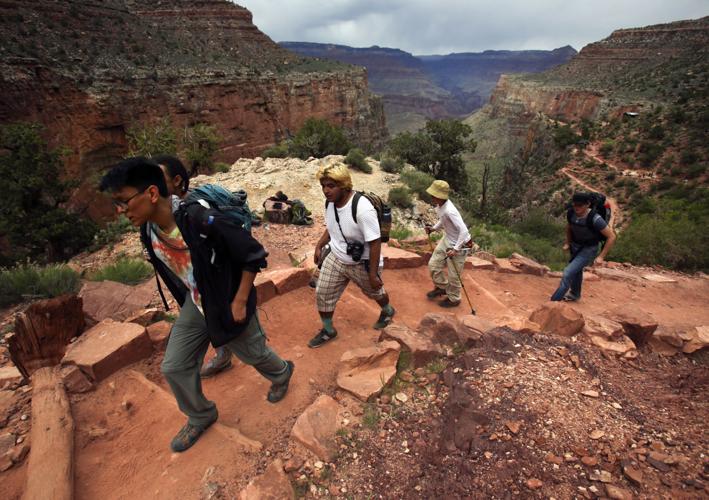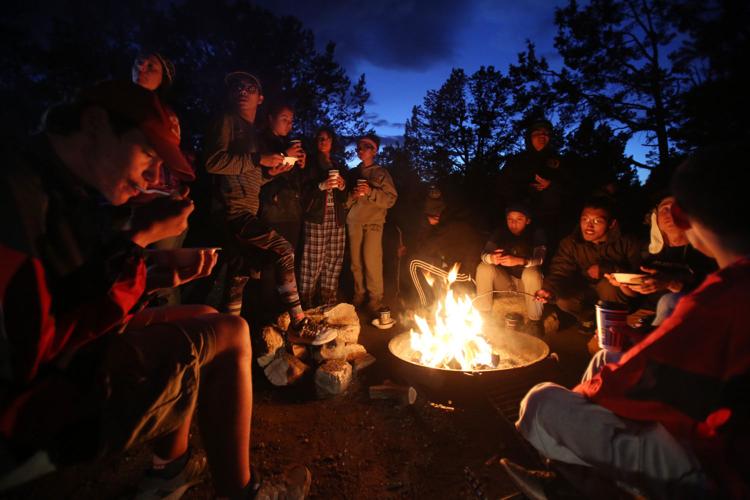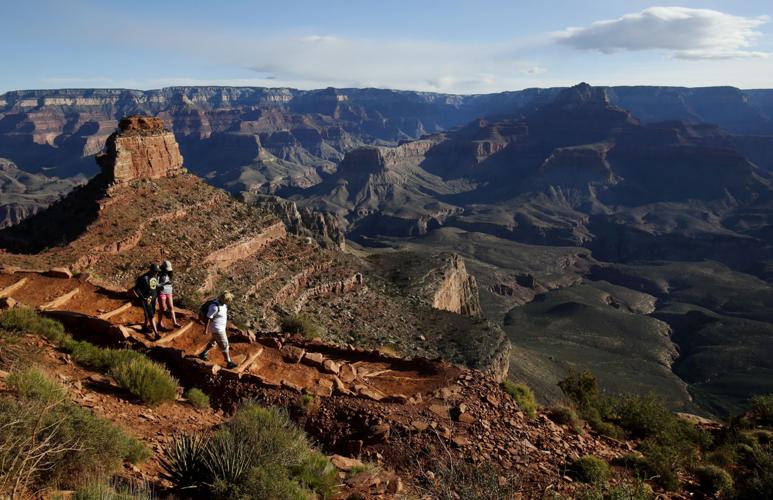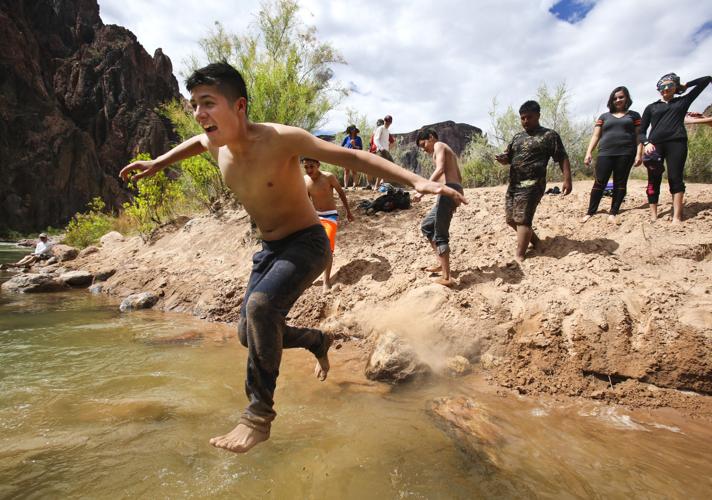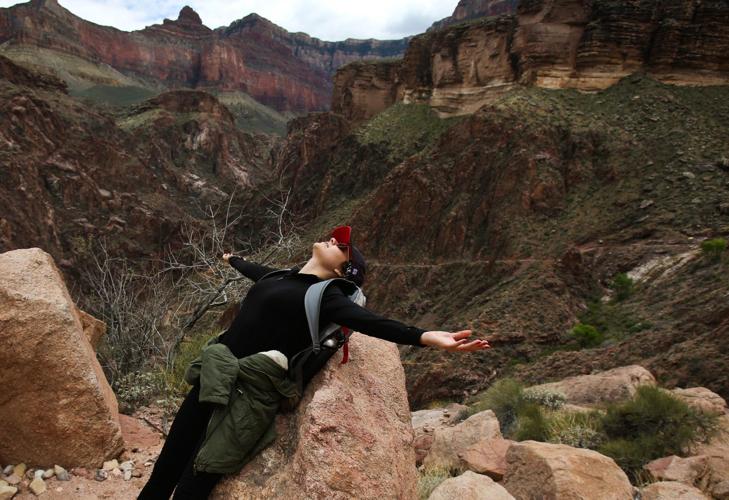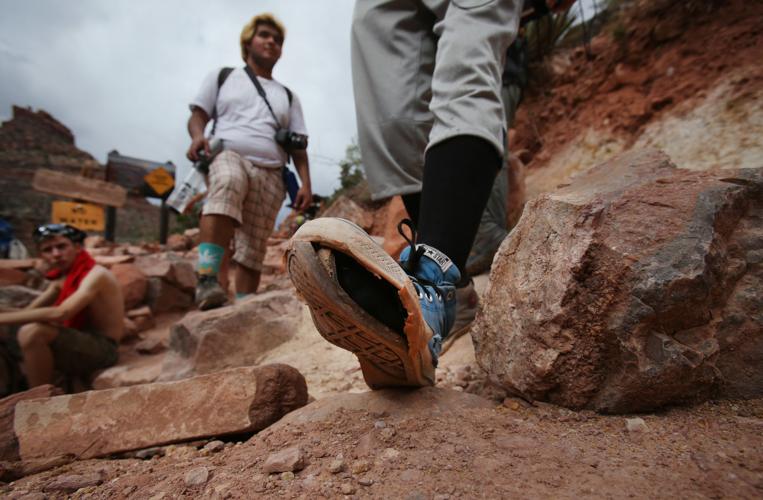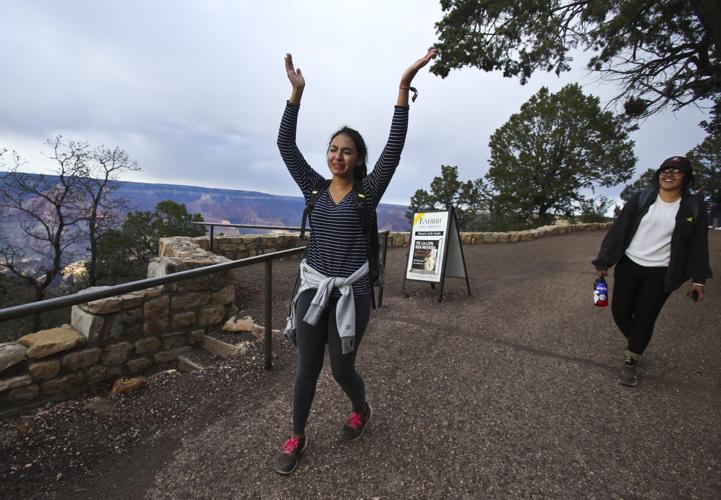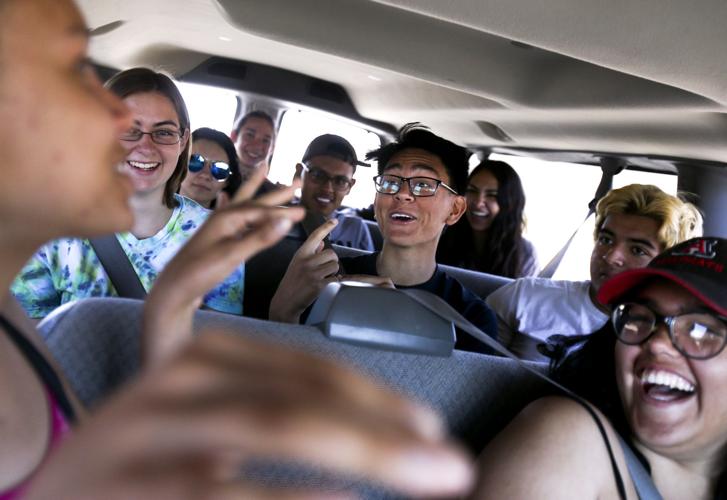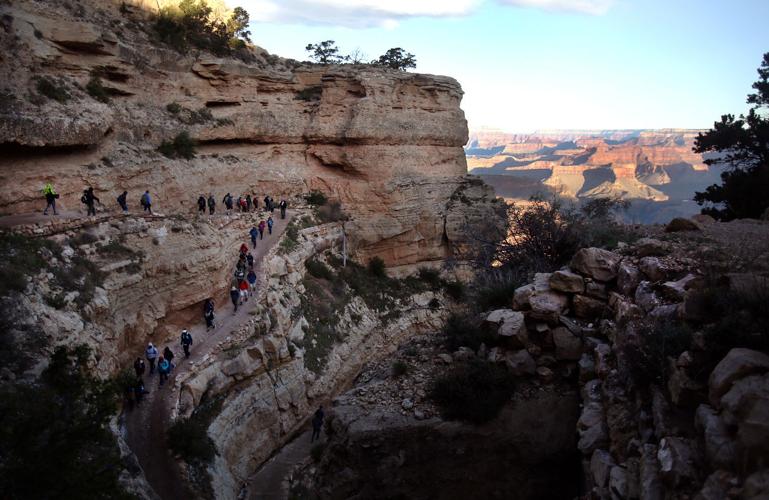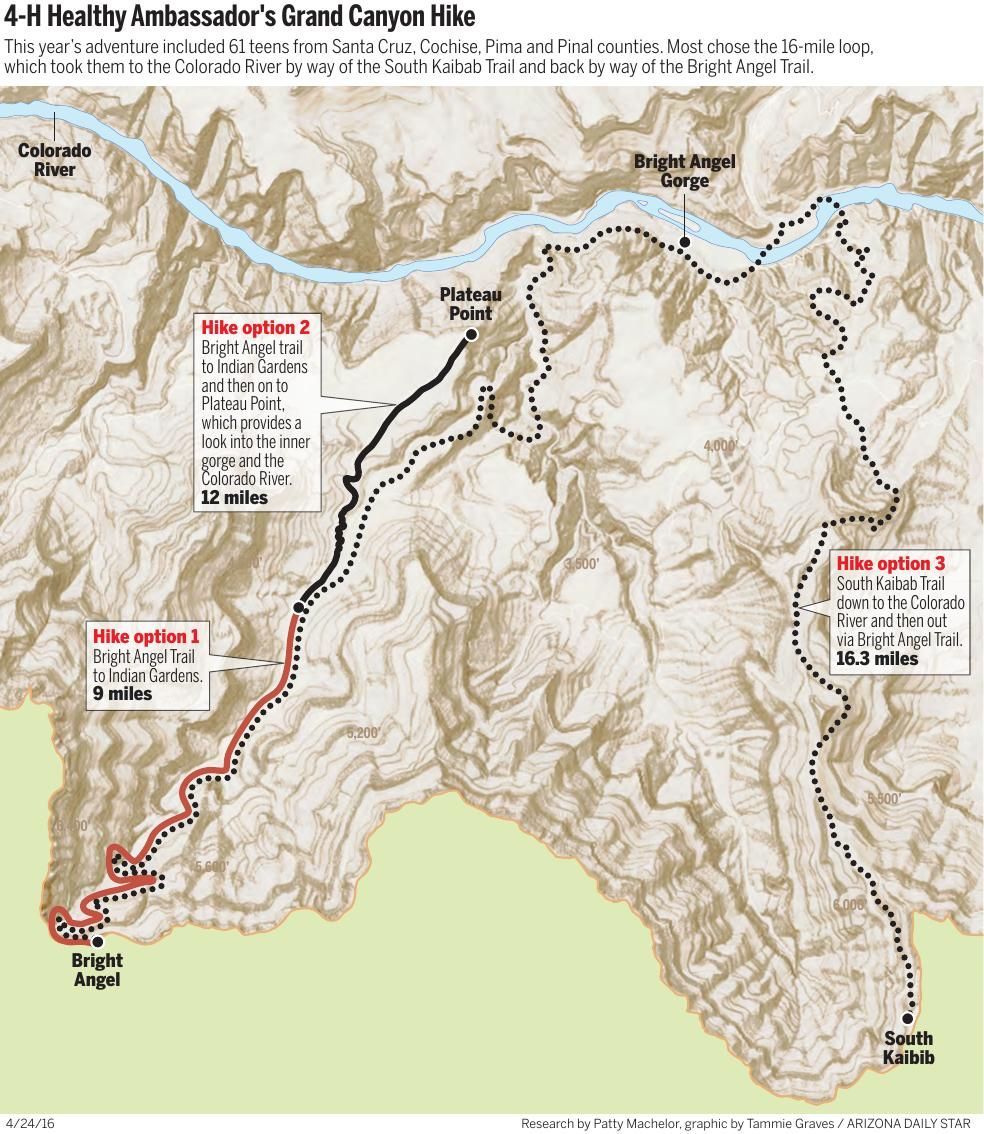Sleet started battering windshields just as the Southern Arizona caravan rolled up to Grand Canyon National Park.
The adults — at least two in each of the 10 vans and trucks — had been watching the horizon from miles back and braced themselves, knowing dark skies likely meant wet feet and frozen fingers for camp set-up.

Sergio Jones, center, and Jennifer Bass, left, get the whole van's attention as they play a word game on the drive north.
But for most of the 61 teens there to hike the canyon one week ago, the accumulating sleet-turned-to-snow signified something different.
As doors flew open at the campground site, they laughed in delight, exhilarated by this cold, soggy offering. Feet slipped and snowballs flew before the focus shifted to getting tents set up, and dozens of people fed, before nightfall’s frigid temps.
Cultivating both this exuberance and this cooperation is the aim for Pima County’s Elizabeth Sparks and her 4-H cohorts. And seeing it play out provides them with the energy needed to manage all these kids, to make sure they venture into the world’s most spectacular canyon hydrated, sun-blocked and well-fed.

Sergio Jones, center, from Pima County, whoops in approval of the snowfall that met the group upon arrival to the Grand Canyon National Park campground.
Up! Up! Up!
Group one was up before sunrise, preparing for a 16-miler down South Kaibab Trail to the Colorado River and then out by way of the Bright Angel Trail. As they filled water bottles and camelbacks, the smaller group, doing 12-miles to Plateau Point and back, savored the warmth of their sleeping bags a bit longer.
The campsite filled with a low buzz as leaders and teens from Pinal, Santa Cruz, Cochise and Pima counties prepared their packs and ate a quick meal of hot cereal, and bagels and cream cheese.
Increasing light meant it was time to start moving it along, as the hikers needed to be out of the canyon by sundown.
“If you are standing around,” Sparks announced loudly to the milling group, “you’re doing it wrong!”
Such proclamations are made regularly by Sparks, the 4-H Youth Development assistant agent for the Pima County Cooperative Extension. On the second morning, with camp breakdown and a long ride home looming, Sparks’ simple announcement stirred the sleeping hikers: “Up! Up! Up!”
It’s with such directness and humor that Sparks oversees Tucson Village Farm and its Healthy Living Ambassador program, through which teens and preteens — many from at-risk backgrounds — learn about nutrition, food budgeting and preparation. After training, they take what they’ve learned back into their communities.

Hikers descend the South Kaibab trail early Saturday morning.
Hiking the Grand Canyon was added to the program a year ago when Sparks and Natalie Shepp, program coordinator for the Healthy Living Ambassador program, decided it was time to rejoin Apache County’s 4-H agent Mike Hauser on his annual trek.
Sparks first took a bunch of Pima County 4-H kids to join Hauser nine years ago, but they only went once after he switched his trip from October to April.
Teaching teens how to prepare for something as challenging as a hike into the Grand Canyon is a great way to teach them many things, said Dan McDonald, an associate area agent for the Pima County Cooperative Extension who supervises nutrition education programs.
McDonald, an avid runner, led the teens who opted for the shorter hike.
“I am just floored watching the young people and how tremendously supportive they are of each other,” he said. “Depending on the pace that they are hiking, they are hiking with a lot of kids that they don’t know, but still they are bonding and supporting each other, and together accomplishing the goal that they’ve set.”
Hauser and his group of 48 camped nearby this year, with each site handling their own food preparations. But he stopped by frequently to regale the Southern Arizona group with tales of the canyon, including one about a man not fit enough to make it out before nightfall who spent the night in the canyon.
Through Hauser’s storytelling, some critically important things were imparted: Drink water and eat well, and don’t take on more miles than you can handle.
In love with earth
The Colorado River divides the park into the North Rim and the South Rim, which is where the teen hikers embarked. Those doing the longer hike weaved down to a 277-mile long gorge and, within it, the river.
The elevation change from rim to river by way of the 6.3-mile South Kaibab Trail is 4,860 feet. The trail is very steep, so much so that the National Park Service recommends only using it for descent. The hike out, then, is along the Bright Angel Trail, hardly an easy journey with its 70-plus switchbacks.
Many of the students there for their second time were relieved the afternoon sky was overcast this year. While the sun burned down last year, this year’s hike was made gentler with soft breezes and an occasional sprinkle of rain.

Jocelyn Rossete Leon, 19, of Pima County, takes it all in while she stops for a moment on the Bright Angel Trail in the Grand Canyon.The teenaged Healthy Living Ambassadors of the 4-H Youth Leadership program at the Pima County Cooperative Extension took part in a 3-day teen summit trip to the Grand Canyon, with most of the 60-plus students choosing a 14-mile round-trip hike to the bottom of the canyon and back to the rim in one day. Photo taken Saturday, April 16, 2016, at the Grand Canyon National Park in Northern Arizona. Photo by Mike Christy / Arizona Daily Star
Tahlia Segura, 18, said her senses were heightened this year partly due to the weather, she thinks, and partly because she was less concerned about what the hike would entail. She noticed more the dramatic ridges, the softness of the Colorado River sand and the smells: earth, vegetation, rain.
“I just fell more in love with earth,” said Segura, a senior at Tucson High Magnet School. Hiking feels so familiar now, she said. Some of her friends want to do a small backpacking trip to celebrate their upcoming graduation and she is enthusiastically on board.
“I think it helps me remind myself that my life is not all about homework due dates and test scores,” said Segura, who plans to attend the University of Arizona in the fall. “I am a part of the earth, the stars, and I am emotionally and physically connecting with everything around me.”
Her young brother, Leon, 17, was along for the first time. In fact, it was his first venture to the forests of Northern Arizona.
“It was beautiful and awe-inspiring,” he said of the canyon. “Even just going in to the canyon just a little bit and seeing the view changes you so much.”

Aldrick Buitimea, 14, from Santa Cruz County, takes a leap into the waters of the Colorado River at the bottom of the canyon. The hikes included students from Pinal, Santa Cruz, Cochise and Pima counties.
Learning to persevere through the discomfort and the sweat is part of the process, said Sergio Jones, 17, a senior at BASIS Tucson North. Finishing the hike: “Fortifying!”
“Knowing what to expect the second time around makes the journey less daunting,” said Jones, who will attend Carleton College in Minnesota in the fall. Instead, he said, the hike was “something to eagerly embark upon, with some amazing friends.”
Ana Garcia, a senior at Nogales High School who plans to attend first Pima Community College and then the UA, said she’d hoped to do the longer hike this year, but decided against it after her knee started giving her grief. She hiked the 12-miler again.
“I’ve always liked a good challenge and hiking never fails at it,” said Garcia, 18. “It is also very satisfying once you get to the top or when you finish, you get a feeling that you can do anything.”

Tucson High Magnet School’s Andres Mendoza shows the wear on his Converse shoes from the Bright Angel Trail hike.
‘Can’t ever be taken away’
Many of the young people Sparks and her staff work with are considered to be at risk, but Sparks believes that term applies to all teens, all children.
Addiction, poor diets and nature deprivation are among the greatest risks, she says. There’s also the risk they’ll never learn the satisfaction that comes with working hard for a goal.
“We have to teach them to find their way,” she said. “We have to arm them with these life skills that they are going to need to be successful adults, to be active and healthy citizens.”
On Monday after the hike, Sparks and Leza Carter, senior program coordinator for Tucson Village Farm, spent the morning scrubbing pots and putting away camping equipment.
“It’s way more fun to pack than to unpack,” Sparks said during a quick phone interview. “But the benefits and what the kids get out of this truly life-changing experience are worth all the challenges, the fundraising, the preparations and the cleaning.”
While they are pre-planning all the time, the work starts in earnest about eight weeks before they leave, with training hikes and workouts. Pre-planning also includes securing the funding that’s needed, and planning nutritious meals.
McDonald helps the group find donors and grants.
The Tucson Osteopathic Medical Foundation provided $1,500 this year, while Summit Hut and the Ironwood Tree Experience both chipped in gear. The also receive funds from the U.S. Department of Agriculture’s Children, Youth and Families at Risk grant program.

Paulina Gutierrez, 16, a student at Sunnyside High School, cheers upon completing the day’s hike.
Next year’s adventure is mostly covered, but after that they will need to start looking for some extra funding again.
The work is all worth it, the staff agrees, when they see the kids plunge into the frigid Colorado River, or take that last, exhausted step out of the canyon.
“It’s something that can’t ever be taken away,” Sparks said. “Every time they see a picture of the Grand Canyon, they can remember.”


